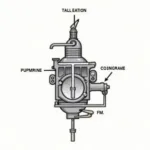The Mitsubishi Eclipse – a name that immediately conjures up images of tuned sports coupes and adrenaline-fueled chases from the “Fast & Furious” film series for car fans. But how did this Japanese sports car become a cult object for an entire generation? This article delves into the history of the Mitsubishi Eclipse, its role in “The Fast and the Furious,” and highlights why it continues to fascinate car enthusiasts worldwide.
The Mitsubishi Eclipse saw the light of day in 1989 and was intended to bring new glory to the Japanese car brand. Conceived as an affordable sports car, it offered a successful blend of performance, design, and value for money. The first generation, produced from 1989 to 1994, impressed with its aggressive design, pop-up headlights, and optional turbo engine.
 First generation Mitsubishi Eclipse (1989-1994) featuring pop-up headlights and an aggressive design.
First generation Mitsubishi Eclipse (1989-1994) featuring pop-up headlights and an aggressive design.
However, the Mitsubishi Eclipse only gained worldwide fame through its appearance in “The Fast and the Furious” (2001). In the film, Brian O’Conner, played by the late Paul Walker, races through the streets of Los Angeles in a green second-generation Mitsubishi Eclipse. The car, a 1995 model with front-wheel drive and a powerful 4G63T engine, was souped up for the film and equipped with a striking body kit, nitrous injection, and other modifications.
“The Eclipse in the film wasn’t just a car, it was a character,” recalls Robert Davies, a fictional car mechanic and specialist in Japanese sports cars. “The car embodied the rebellious energy of the film and became a symbol of speed, tuning, and the pursuit of freedom.”
The success of the film triggered a veritable hype surrounding the Mitsubishi Eclipse. Suddenly, young people all over the world dreamed of cruising the streets in a tuned Eclipse. The film turned the car into a cult object and inspired an entire generation of car enthusiasts.
But the Eclipse had more to offer than just its Hollywood appearance. The second generation (1995-1999) impressed with an even more aggressive design and improved performance. The third generation (2000-2005) and fourth generation (2006-2012) also scored points with sporty driving characteristics and an attractive price.
The Mitsubishi Eclipse was discontinued in 2012, but its legend lives on. At car meets and on the internet, you can find countless fans who share their love for the Eclipse and passionately maintain and tune their vehicles.
The Mitsubishi Eclipse: A Legacy of Speed
The Mitsubishi Eclipse has had a lasting impact on the world of sports cars. It proved that affordable driving pleasure and breathtaking design do not have to be mutually exclusive. Its appearance in “The Fast and the Furious” catapulted it into the Olympus of cult cars and inspired an entire generation.
Even though the Eclipse is no longer produced, we fondly remember its history and the emotions it triggered in millions of people around the world.
Further questions about the Mitsubishi Eclipse:
- What tuning options are there for the Mitsubishi Eclipse?
- How do I properly maintain my Mitsubishi Eclipse?
- Where can I find spare parts for my Mitsubishi Eclipse?
We are happy to answer these and other questions about car repairs and maintenance at autorepairaid.com. Our experts are at your side with advice and support.
Contact us today and let us share your passion for cars together!

